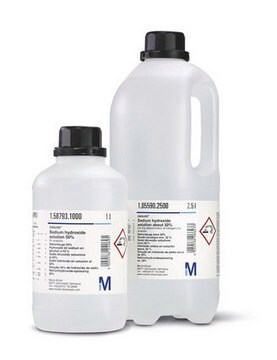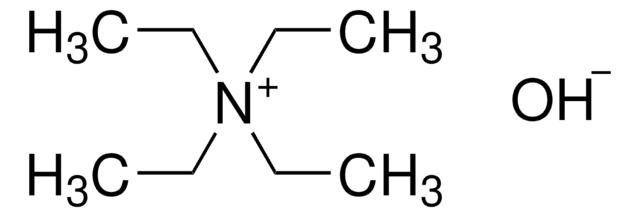1.08124
Tetramethylammonium hydroxide solution
c(C₄H₁₃NO)=0.1 mol/l (0.1 N) in 2-propanol/methanol, ready-to-use volumetric solution for titration in non-aqueous media, Titriplex®
About This Item
Prodotti consigliati
Nome del prodotto
Tetramethylammonium hydroxide solution, in 2-propanol/methanol for titrations in non-aqueous media c(C4H13NO)=0.1 mol/l (0.1 N), Titripur®
Livello qualitativo
Nome Commerciale
Titripur®
Stato
liquid
Qualità
Analyzed in our ISO 17025 accredited QC lab
Impiego in reazioni chimiche
reaction type: Acid-base reactions
reaction type: Redox Reactions
Concentrazione
0.1 M
tecniche
titration: suitable
pH
14 (20 °C in H2O)
Temp. transizione
flash point 15 °C
Densità
0.79 g/cm3 at 20 °C
Temperatura di conservazione
15-25°C
Categorie correlate
Applicazioni
- An Approach Based on an Increased Bandpass for Enabling the Use of Internal Standards in Single Particle ICP-MS: Application to AuNPs Characterization.: This study by Bazo et al. (2023) explores the use of Tetramethylammonium hydroxide solution to enhance internal standard applications in single particle ICP-MS for gold nanoparticle characterization. This method improves accuracy and reliability in nanoparticle detection (Bazo et al., 2023).
- Titanium dioxide nanoparticles assessment in seaweeds by single particle inductively coupled plasma - Mass spectrometry.: López-Mayán et al. (2022) utilized Tetramethylammonium hydroxide solution for the assessment of titanium dioxide nanoparticles in seaweeds. This approach allows for precise quantification and analysis of nanoparticles in complex matrices (López-Mayán et al., 2022).
- Determination of selenite and selenomethionine in kefir grains by reversed-phase high-performance liquid chromatography-inductively coupled plasma-optical emission spectrometry.: Bodur et al. (2021) used Tetramethylammonium hydroxide solution to effectively separate and quantify selenite and selenomethionine in kefir grains, demonstrating its utility in food chemistry applications (Bodur et al., 2021).
- Application of TMAH thermochemolysis to the detection of nucleobases: Application to the MOMA and SAM space experiment.: He et al. (2019) applied Tetramethylammonium hydroxide solution in thermochemolysis for detecting nucleobases in space mission experiments, demonstrating its application in astrobiology and space chemistry (He et al., 2019).
Caratteristiche e vantaggi
This volumetric solution is analyzed by our calibration laboratory D-K-15185-01-00 which is accredited according to DIN EN ISO/IEC 17025 for analysis of amount-of-substance concentrations in volumetric solutions by DAkkS (Deutsche Akkreditierungsstelle - German National Accreditation Body). The accreditation certificate can be found at www.sigmaaldrich.com/ISO17025.
Risultati analitici
Amount-of-substance concentration 0.0994 - 1.006 mol/L
Measurement uncertainty ± 0.0004 mol/L
Traceability NIST SRM
The concentration is determined by volumetric titration and refers to 20°C.
The amount-of-substance concentration of this volumetric solution is traceable to a primary standard reference material (SRM) from the National Institute of Standards and Technology, Gaithersburg, USA (NIST SRM 350 benzoic acid) by means of volumetric standard benzoic acid (article number 1.02401), certified reference material according to ISO 17034, analyzed by our accredited calibration laboratory of Merck KGaA, Darmstadt, Germany according to DIN EN ISO/IEC 17025. The uncertainty is expressed as expanded measurement uncertainty with a coverage factor k=2 covering a confidence level of 95%.
Note: The titer is a correction factor to correct for variations of the volumetric solution, the titration equipment, the temperature and other laboratory conditions. For correct titration results it is recommended to determine a titer with the laboratory specific equipment and under laboratory specific conditions directly after opening a new bottle and at regular time intervals.
Note legali
Prodotti correlati
Avvertenze
Danger
Indicazioni di pericolo
Classi di pericolo
Acute Tox. 3 Dermal - Acute Tox. 3 Oral - Acute Tox. 4 Inhalation - Eye Dam. 1 - Flam. Liq. 2 - Skin Corr. 1 - STOT RE 2 Dermal - STOT SE 1 - STOT SE 3
Organi bersaglio
Central nervous system
Codice della classe di stoccaggio
3 - Flammable liquids
Classe di pericolosità dell'acqua (WGK)
WGK 2
Punto d’infiammabilità (°F)
59.0 °F
Punto d’infiammabilità (°C)
15 °C
Certificati d'analisi (COA)
Cerca il Certificati d'analisi (COA) digitando il numero di lotto/batch corrispondente. I numeri di lotto o di batch sono stampati sull'etichetta dei prodotti dopo la parola ‘Lotto’ o ‘Batch’.
Possiedi già questo prodotto?
I documenti relativi ai prodotti acquistati recentemente sono disponibili nell’Archivio dei documenti.
I clienti hanno visto anche
Il team dei nostri ricercatori vanta grande esperienza in tutte le aree della ricerca quali Life Science, scienza dei materiali, sintesi chimica, cromatografia, discipline analitiche, ecc..
Contatta l'Assistenza Tecnica.


![Soluzione di tetra-n-butilammonio idrossido in 2-propanol/methanol for titrations in nonaqueous media c[(C4H9)4NOH] = 0.1 mol/l (0.1 N), Titripur®, reag. USP](/deepweb/assets/sigmaaldrich/product/images/217/795/18cba546-7592-4bb4-8b67-0b4b229e0a2f/640/18cba546-7592-4bb4-8b67-0b4b229e0a2f.jpg)







